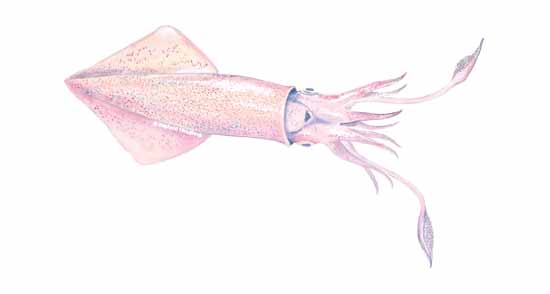Squid
Published on
January 23, 2014

Squid are cephalopods, a word meaning “head foot.” They are a close relative of the octopus and a distant relative of bivalve mollusks. More than 300 species inhabit the world’s oceans, but fewer than a dozen comprise 90 percent of the global catch; of them, three comprise the domestic suppy. West Coast “market squid” (L. opalescens) are 3 to 5 inches long; East Coast squid, including long-finned “winter squid” (L. pealei) and short-finned “summer squid” (Illex illecebrosus), are a bit larger. Summer squid is the largest commercial species. West Coast squid, found from Alaska to California, are caught with purse seines from “light boats” that lure them to the surface from depths of 60 to 200 feet with high-intensity lamps. On the East Coast, squid are trawled and trapped from Canada to North Carolina in coastal waters and up to 200 miles offshore. Because the domestic market prefers a white-meated product, squid are sometimes “bleached” in a brine solution to enhance whiteness.
Loligo spp.; Illex illecebrosus
Squid
California, Monterey, San Pedro or market squid (L. opalescens); long-finned squid, winter squid, Boston squid (L. pealei); short-finned squid, summer squid (I. illecebrosus)
Calmar
Tntenfisch
Calamaro
Ika
Calamar
Squid are cephalopods, a word meaning “head foot.” They are a close relative of the octopus and a distant relative of bivalve mollusks. More than 300 species inhabit the world’s oceans, but fewer than a dozen comprise 90 percent of the global catch; of them, three comprise the domestic suppy. West Coast “market squid” (L. opalescens) are 3 to 5 inches long; East Coast squid, including long-finned “winter squid” (L. pealei) and short-finned “summer squid” (Illex illecebrosus), are a bit larger. Summer squid is the largest commercial species. West Coast squid, found from Alaska to California, are caught with purse seines from “light boats” that lure them to the surface from depths of 60 to 200 feet with high-intensity lamps. On the East Coast, squid are trawled and trapped from Canada to North Carolina in coastal waters and up to 200 miles offshore. Because the domestic market prefers a white-meated product, squid are sometimes “bleached” in a brine solution to enhance whiteness.
Cooked squid is mild and has a subtle sweetness. The meat is firm yet tender. Illex squid has large, 8- to 12-inch tubes and is coarser than Loligo. Raw squid meat is ivory beneath a naturally speckled membrane. Cooked squid is opaque white and firm. Fresh or thawed squid should be moist, shiny and ivory colored. Pink, yellow or purple flesh indicates deterioration.Edible parts of the squid include the arms (tentacles), the mantle (tube) and the fins (wings). The body is covered with a thin skin that may be removed before cooking. Squid ink is often used to make black pasta.
| Calories: | 92 |
| Fat Calories: | 13 |
| Total Fat: | 1.4 g |
| Saturated Fat: | 0.4 g |
| Cholesterol: | 233 mg |
| Sodium: | 44 mg |
| Protein: | 16 g |
| Omega 3: | 0.49 g |
The secret to tender squid is to cook it either quickly or for around 30 minutes. Rings can be battered and fried; mantles can be stuffed and baked in a sauce. Don’t overcook, or squid will turn as tough as a pencil eraser (a couple of minutes are usually enough). If you do overcook, keep cooking for 20 minutes more, and it will become tender again. Braised or baked squid should be cooked this long anyway.
Monkfish medallions, Bay scallops, Halibut cheek
- Bake
- Boil
- Broil
- Fry
- Grill
- Pate
- Poach
- Saute
- Smoke
- Steam
Fresh: Whole, Cleaned
Frozen: Whole, Cleaned, Tubes, Rings, Tentacles (“skirts”)
Value-added: Breaded or unbreaded strip, Marinated, Stuffed, Canned, Dried, Smoked
Argentina, China, India, New Zealand, Peru, Taiwan, United States





